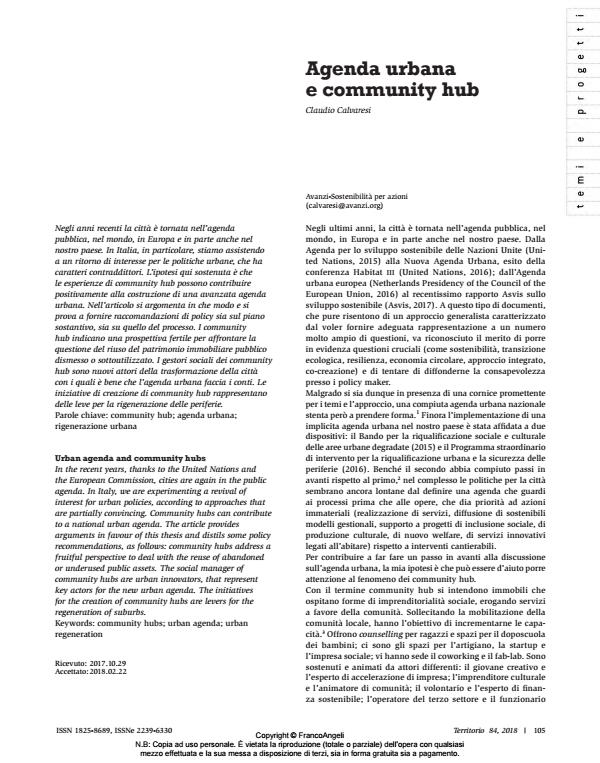Urban agenda and community hubs
Journal title TERRITORIO
Author/s Claudio Calvaresi
Publishing Year 2018 Issue 2018/84
Language Italian Pages 6 P. 105-110 File size 313 KB
DOI 10.3280/TR2018-084016
DOI is like a bar code for intellectual property: to have more infomation
click here
Below, you can see the article first page
If you want to buy this article in PDF format, you can do it, following the instructions to buy download credits

FrancoAngeli is member of Publishers International Linking Association, Inc (PILA), a not-for-profit association which run the CrossRef service enabling links to and from online scholarly content.
In the recent years, thanks to the United Nations and the European Commission, cities are again in the public agenda. In Italy, we are experimenting a revival of interest for urban policies, according to approaches that are partially convincing. Community hubs can contribute to a national urban agenda. The article provides arguments in favour of this thesis and distils some policy recommendations, as follows: community hubs address a fruitful perspective to deal with the reuse of abandoned or underused public assets. The social manager of community hubs are urban innovators, that represent key actors for the new urban agenda. The initiatives for the creation of community hubs are levers for the regeneration of suburbs.
Keywords: Community hubs; urban agenda; urban regeneration
- Building on decay: urban regeneration and social entrepreneurship in Italy through culture and the arts Sara Bonini Baraldi, Carlo Salone, in European Planning Studies /2022 pp.2102
DOI: 10.1080/09654313.2022.2030675 - Placemaking in the Post-Pandemic Context: Innovation Hubs and New Urban Factories Luca Tricarico, in Sustainability /2024 pp.1030
DOI: 10.3390/su16031030 - Sport and Quality of Life Luca Benvenga, Elisabetta Trinca, pp.243 (ISBN:978-3-030-93091-2)
- Territory, Economy, Society and Institutions in Transition Alessandro Balducci, in disP - The Planning Review /2019 pp.60
DOI: 10.1080/02513625.2019.1708072 - Enabling real property. How public real estate assets can serve urban regeneration Ezio Micelli, in TERRITORIO 87/2019 pp.93
DOI: 10.3280/TR2018-087015
Claudio Calvaresi, Agenda urbana e community hub in "TERRITORIO" 84/2018, pp 105-110, DOI: 10.3280/TR2018-084016